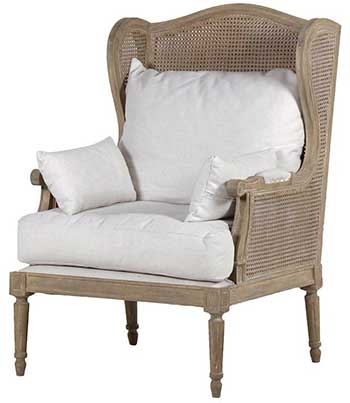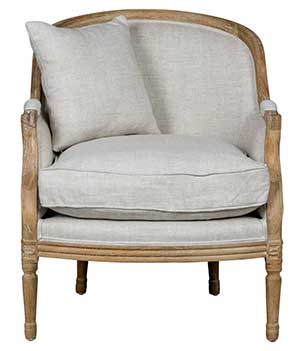We all have that friend or relative who loves antique furniture. Even modern manufacturers will often produce new chairs based on classic styles. A very popular type of early upholstered armchair was the Bergère chair.
Join us as we take a look at the different types of Bergère chairs and what makes this design so unique from the rest of the antique chair designs.
What Is a Bergère Chair?
A Bergère chair (pronounced like bair-jair), is a type of upholstered armchair that originates from early designs of the 18th century. It has closed sides, as compared to open armrests seen in other types of early chairs.

It was the first type of chair to focus on comfort and relaxation. Prior chair designs were often rigid and uncomfortable. The sides of the chair are usually upholstered but can be made of cane depending on the design.
Padded elbow rests are often found on the armrests. The seat is fitted with a loose cushion. The design is meant to be used for extended lounging. A deeper and wider design is present here, as compared to that of a fauteuil chair.
An exception would be the bergères by Bellangé that are in the United States White House. These are designed with a more formal appearance.
In the spirit of comfort, the Bergère chair was designed with a long and wide seat that includes a thick cushion. Depending on the type, the back can be high or low. It can also be shaped to be curved, rounded, or conical.
The wood used in the arms and back trimming is painted, gilded, or even natural depending on the specific design approach. The frame can be moulded or carved. It is made from beech or fruitwood, walnut or mahogany. The frame has a waxed finish.
While it was originally found in homes of the 18th and 19th centuries, it is a style still used today in many homes.
The 3 Types of Bergère Chairs
To qualify as a Bergère chair, it must have an upholstered back, seat frame, armrests, a loose cushion, and exposed frames. There are three major variations of this design:



Bergère à la Reine
This first type has high armrests and a flat back. The back is high with a straight top and a sloped shape down to the arms.

Bergère en cabriolet
Our second type of Bergère chair has a rounded back. It is often lower than the first type, coming up to the middle of your back or so depending on height. The armrests are lower as well to match the relative height of the back.


Bergère marquise
Our final style has a low and curved back that seamlessly connects to the arms. This is a thinner back design that is higher than the second type. There’s a distinct difference between the height of the back and the arms in this variation.
The History of Bergère Chairs
The Bergère chair is part of a larger category of chairs inspired by Kings Louis XIV, Louis XV, and Louis XVI. Known as the chair of kings, these chairs were referred to as “Fauteuil” which means “armchair” in French.

The Bergère chair specifically has a wider and deeper seat than any other chair in this category. This design has inspired countless variations in terms of color and patterns.
The first of these King Louis chairs emerged in the 1600’s near the end of Louis XIV’s reign in France. These first Baroque styled chairs were extremely popular during that time. As the design evolved, we began to see lighter and more refined designs.
By the 1800’s, a common French salon would have a sofa, a chaise lounge, and an armchair, possibly even a Bergère chair. During this time, many chairs were ordered as part of a larger suite.
These sets would include side chairs, armchairs, settees, stools, fire screens, folding screens, and a daybed. All of these would have matching upholstery. During the late Baroque period, chairs were formal with stiff and rectangular backs.
As time went on, the designs shifted to become more comfortable. The arrival of the Régence era (1710-35), brought the inclusion of symmetrical curves. The overall decoration also became freer and allowed for additional carvings and accents.
It is not uncommon to see these types of chairs in modern households. One thing that all chairs of this time have in common, is a sense of timelessness. They have evolved and remained a staple of luxury furniture over the years.
A Classic Design for Modern Luxury
The Bergère chair is a design that has stood the test of time. These chairs combine a comfortable feel with a classic design. You can find antique specimens, but many modern manufacturers will make them as well.
All three types of Bergère chairs include armrests and a comfortable cushion. Regardless of which one you choose, you’ll find a chair that can really add to the appeal of a room and function as a comfortable seat for any of your guests.
Pronunciation is more like Bair Jair actually.
We think you’re right Suzi. We’ll update the section.
Thank you very much for your contribution 🙂
I’m trying to identify the possible style and age of a chair I purchased to refinish. Wondering if there is a way to share a photo with you?
Hi Kimberly,
You can upload your picture/s to a site like https://postimages.org/ and post a reply with the link/s to your photos.
Thank you for publishing such an informative article! I’ve become fascinated with furniture styles, and this week: the Bergere Chair. My interest came from having a house fire and needing to furnish the house after it was re-built. I didn’t want new furniture because it looks …. all alike, bland, characterless, soul-less. And I couldn’t afford to seek out beautiful designer chairs. I’ve been snuffling around on-line sales and acquiring cast-offs that might be torn and gouged, but have BEAUTIFUL “bones,” and have a timeless quality about them. And that raised the question: What IS this chair? The internet is a wonderful source of information and you have contributed a perfect informational article to it. Thank you for enriching my education!
Wow! What a beautiful message!
We’re so glad this article was helpful to you.
You made our day 🙂
Hello! I have been reading some of your articles and notice that you sometimes assist people in determining the type of chairs we may have. Would it be possible for you to look at some pictures of a pair of antique chairs that I have to help me determine what they may be? I purchased them 15 yrs. ago from a private party who had just had them re-upholered. I’ve had them in a room where they rarely are sat upon so the upholstery is still in like new condition.
I am trying to determine if they are something we will want to keep or if we should sell them to help cover some unexpected expenses and any info. you can share with me regarding these chairs will be very helpful. Thank you so much for your time and any assistance, and for the wealth of information you have on your website. It was so interesting learning some of the history of different types of chairs.
With gratitude,
Julie
Hello Julie, and thank you for the question!
Based on the photos you sent, it definitely has the shape and styling of a club chair, but that’s probably not enough information to be genuinely helpful.
The first thing we’d recommend is to check the bottom of the chair to see if or whether the chair’s designer left a mark which would go a long way toward narrowing the field and determining when and where the chair was originally made.
Our research also turned up a pair of internet forums that people have used to help with the identification of a wide range of antique furniture. First, there’s the forum at Scavengerlife.com:
https://www.scavengerlife.com/forums/forum/identification-what-is-this-thing/
And then, there’s a similar forum at Designaddict.com:
https://designaddict.com/community/identification/
Either of these sites will likely be able to help you zero in on exactly who made the chair and place it appropriately in time.
My friends have asked me to sell their Bergere furniture on an auction site but are unsure of the actual age. Is there a way to determine this?
There is a sofa, 3 different sized chairs and food stool, made from solid wood with double framed rattan sides and backs. Would it be possible to send over some photographs?
Thank you
Sure Linda, we can take a look. Contact us here.
Hello. I bought a chair from a local shop. I have been told it is a bergere..is it possible to get some idea of value?..
Hey Kat,
Send us a link to a picture so we can take a look and see if we can help or point you in the right direction.
Thanks for stopping by 🙂
Hi, I wondered if we sent some photos of what we believe to be a Bergere suite you may be able to guide us on a price. It was left to us in an estate and we have seen varying values for these types of suites.
Many thanks
Hi Chris,
Just because we love the subject, we would love to take a look and give it a try. If it’s out of our scope we’ll try to put you in touch with someone who can help you.
You can add a reply to this message or contact us here: https://chairinstitute.com/contact-us/
Thanks for stopping by!
I have an interesting antique (I believe) bergere chair that I cannot find any information on. I was wondering if you could help me, please. Thank you.
Stacy
Hello Stacy,
Please let us know a bit more about your chair, and maybe send us some pictures?
We’ll try to be of help.
Best regards